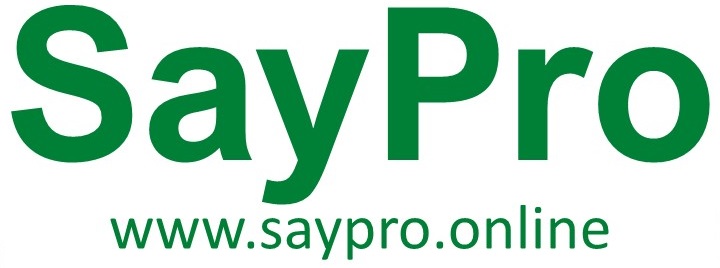SayPro Stakeholder Communication: Regularly communicate with stakeholders (sellers, customers, internal teams) to ensure that the events align with their expectations and needs from SayPro Monthly February SCMR-17 SayPro Quarterly Event Management by SayPro Online Marketplace Office under SayPro Marketing Royalty
Objective: Foster Transparent, Continuous Communication with Stakeholders
Effective stakeholder communication is a cornerstone of successful event planning and execution. The SayPro Online Marketplace Office, under the direction of SayPro Marketing Royalty, ensures that all quarterly and monthly events—including those under February SCMR-17—are developed and refined through active feedback loops with the platform’s primary stakeholders: sellers, customers, and internal teams.
By maintaining open and regular communication with these groups, SayPro not only enhances the relevance and impact of each event, but also strengthens trust, alignment, and community participation across the entire marketplace ecosystem.
Key Objectives of Stakeholder Communication
- Ensure Relevance: Validate that events directly address stakeholder needs and priorities.
- Manage Expectations: Keep all parties informed about event goals, content, timelines, and outcomes.
- Foster Engagement: Involve stakeholders in planning and post-event feedback to foster a sense of inclusion and ownership.
- Encourage Collaboration: Enable two-way communication between SayPro and stakeholders to identify emerging needs and collaborative opportunities.
- Strengthen Platform Trust: Build credibility through transparency, consistency, and responsiveness.
Stakeholder Communication Strategy
1. Identify and Categorize Stakeholders
To tailor communication effectively, the SayPro team segments stakeholders into three primary categories:
- Sellers: Marketplace vendors and store owners who rely on SayPro’s platform for business growth.
- Customers: End-users who interact with and purchase from the platform.
- Internal Teams: SayPro staff across departments (marketing, product development, customer service, tech) who contribute to or are affected by the event initiatives.
Each group has distinct communication needs and expectations that must be addressed before, during, and after events.
2. Communication Methods and Tools
SayPro uses a combination of digital and personal communication methods to keep stakeholders engaged:
| Stakeholder Group | Primary Channels | Purpose |
|---|---|---|
| Sellers | Email newsletters, WhatsApp groups, webinar briefings | Event invitations, feedback collection, updates |
| Customers | Email campaigns, website banners, in-app notifications | Awareness, participation encouragement |
| Internal Teams | Internal memos, Slack/Teams messages, planning meetings | Coordination, alignment, resource planning |
In addition, SayPro hosts monthly virtual check-ins and quarterly review sessions for sellers and internal departments to reflect on past events and co-create new ones.
3. Pre-Event Communication Tactics
a. Gather Stakeholder Input
- Surveys and Polls: Send short pre-event surveys to sellers and customers asking what topics or features they’d like to see.
- Example: “Which marketplace challenges would you like us to address in our next workshop?”
- Focus Groups: Convene small virtual groups of sellers or power-users to gather qualitative insights on what they need from upcoming events.
- Internal Roundtables: Organize brainstorming sessions with internal teams to ensure logistics, tech, and messaging are in sync.
b. Distribute Clear Event Information
- Provide timely and detailed event overviews through email, messaging platforms, and dashboard notifications.
- Include:
- Event objectives and agenda
- How stakeholders will benefit
- Actionable items (e.g., RSVP links, material downloads)
4. During-Event Engagement
- Real-Time Feedback Channels:
- Use live Q&A tools and chat features to let attendees submit feedback during sessions.
- Encourage participation through polls or shout-outs.
- Moderators and Community Managers: Assign staff to monitor communication channels and ensure stakeholders’ concerns are addressed in real time.
- Internal Coordination Channels: Maintain backstage communication (via Slack, Microsoft Teams) among SayPro teams to resolve any event issues immediately.
5. Post-Event Communication
a. Collect Stakeholder Feedback
- Post-event surveys tailored for:
- Sellers: Did the training improve your understanding of the platform?
- Customers: Was the session helpful in finding or purchasing products?
- Internal Teams: Did the event meet execution and engagement targets?
- Feedback Forums and Comment Threads: Allow attendees to comment openly on event pages or within community forums.
b. Share Outcomes and Next Steps
- Send event wrap-up emails that include:
- Key highlights or recordings
- A summary of participant feedback
- Action items (e.g., follow-up resources or upcoming events)
- Recognize top contributors (e.g., most engaged sellers or speakers) in community spaces to build loyalty and visibility.
6. Continuous Improvement through Ongoing Communication
- Monthly Reports: Share brief reports or dashboards with key stakeholders summarizing:
- Event performance metrics
- Key learnings
- Planned improvements
- Open Communication Channels: Maintain open lines through community support groups, suggestion forms, and seller/customer advisory panels.
Stakeholder Communication Timeline for February SCMR-17
| Date | Activity | Audience | Purpose |
|---|---|---|---|
| [Insert Date] | Survey Distribution | Sellers, Customers | Understand needs and expectations |
| [Insert Date] | Internal Planning Sync | SayPro Teams | Align logistics and goals |
| [Insert Date] | Event Overview Communication | All Stakeholders | Share detailed agenda and participation info |
| [Insert Date] | Live Event Support & Interaction | All Attendees | Enable real-time feedback and participation |
| [Insert Date] | Post-Event Surveys & Thank-You Messages | All Participants | Collect feedback, express appreciation |
| [Insert Date] | Performance Summary & Next Steps | Internal Teams | Guide refinements for future event planning |
Expected Outcomes
- Increased Event Relevance: Events reflect the actual needs of sellers and customers.
- Higher Engagement: Active stakeholder participation throughout the event lifecycle.
- Improved Internal Coordination: SayPro teams are aligned on responsibilities and event goals.
- Data-Driven Improvements: Stakeholder feedback directly informs future event planning.
- Enhanced Stakeholder Trust: Stakeholders feel heard and valued, increasing loyalty to the SayPro platform.
